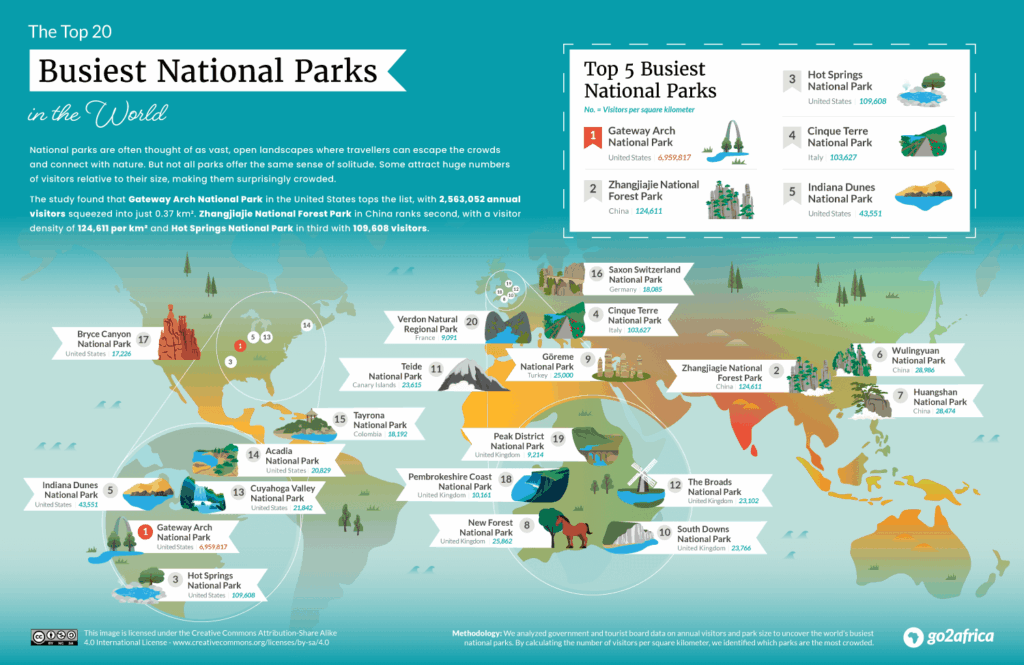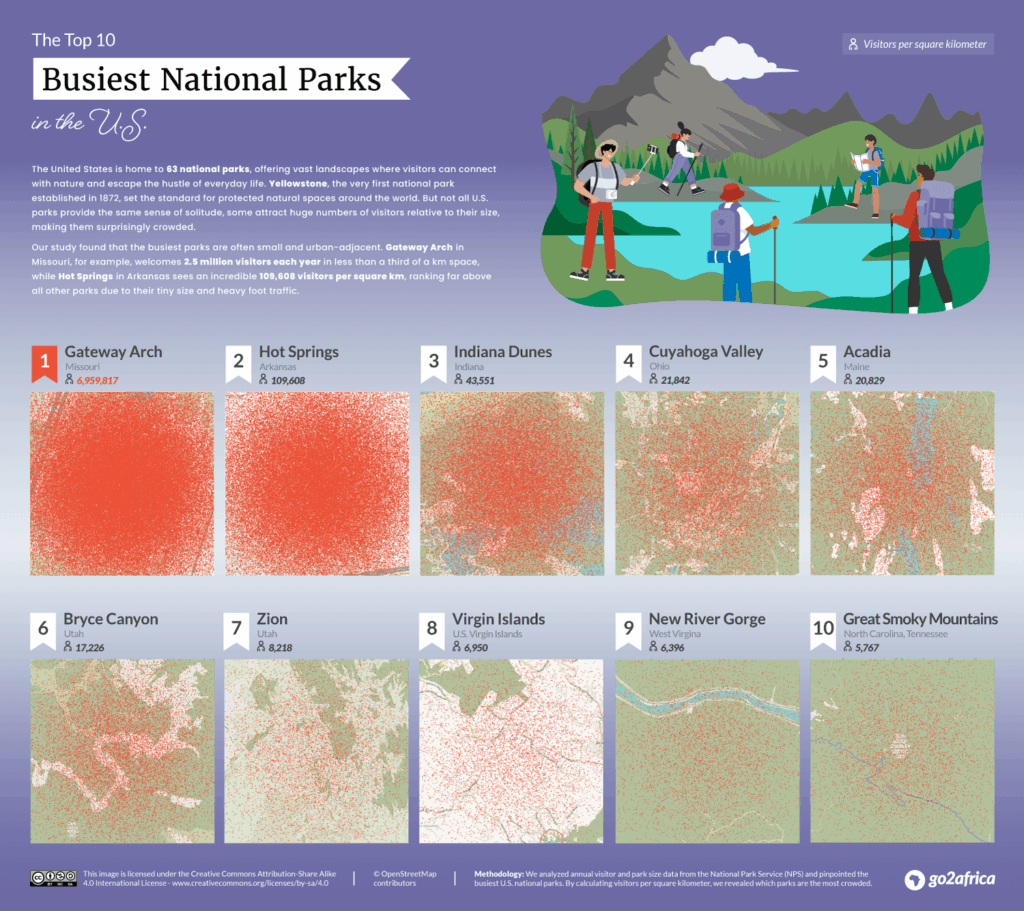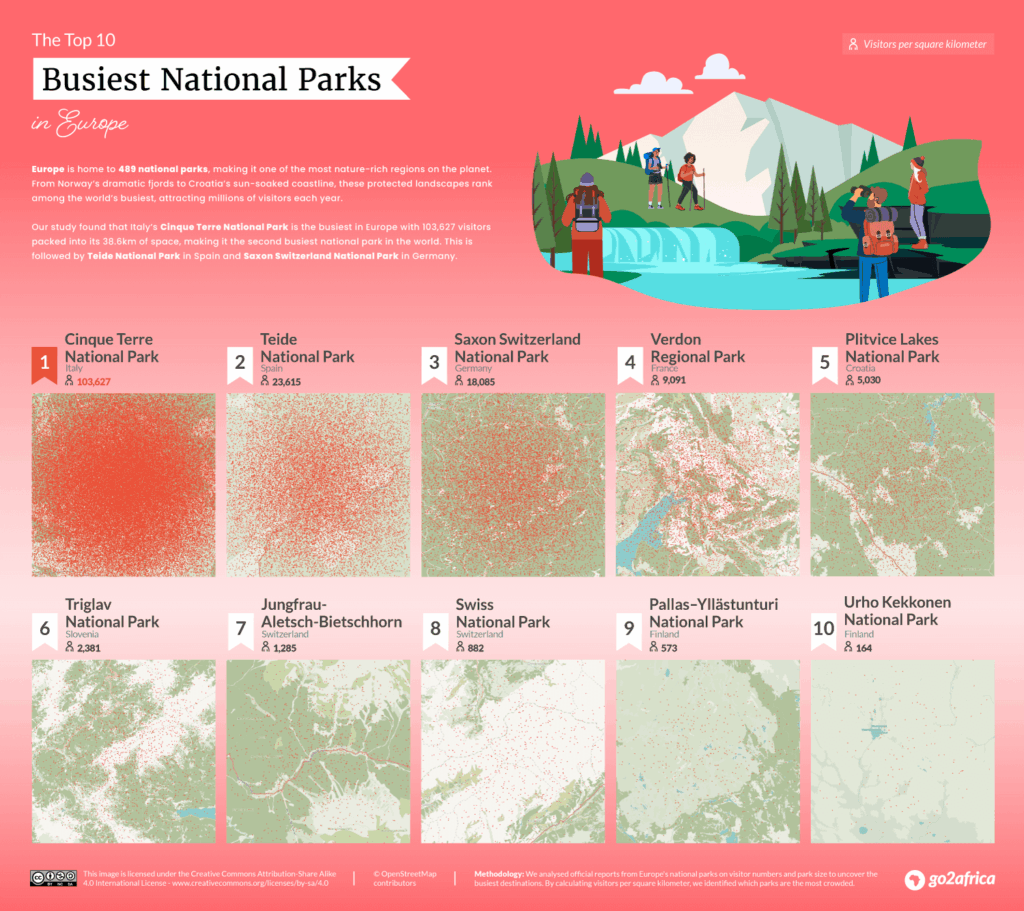Language
- English
- Español
Currency
- AUD Australian Dollar
- CAD Canadian Dollar
- EUR Euro
- GBP Pound Sterling
- USD US Dollar
- ZAR Rand

National parks are sanctuaries for both people and wildlife. They protect rare ecosystems, preserve cultural and natural heritage, and give us the chance to experience the world in its most unspoiled form.
Yet in recent years, the very places designed to protect nature have come under mounting strain from overtourism.
Social media has played a significant role in this trend, amplifying the popularity of national parks with travellers eager to visit the same locations. In 2025, this has been especially true for the Dolomites in Italy which can see up to 35 million visitors a year. This has meant that landowners have started to install turnstiles at the beginning of hiking trails to charge visitors to use the area.
Earlier this year, the data team at Go2Africa discovered the most overcrowded tourist destinations in the world by analyzing visitor numbers alongside local populations.
Building on this report, the same team set out to take a closer look at national parks on a global scale, analyzing 156 of the world's most popular parks. By comparing their annual visitor numbers with their size, they identified which parks are truly the busiest.
Explore the data below to find out which national parks are the most visited.
To conduct the study, Go2Africa gathered official tourism figures from national park tourist boards and government reports to determine the number of visitors to each national park. These figures were then compared to the size of the national park, allowing the team to calculate visitor density – the number of visitors per square kilometer of land for each location.
Not all national parks are vast wildernesses where you can wander for days without seeing another soul. Some are surprisingly compact, drawing millions of visitors into relatively small spaces and creating some of the highest visitor densities anywhere in the world.

According to the study, Gateway Arch National Park ranks as the busiest national park in the world. Located in Missouri, the national park is much smaller than its U.S. neighbours with a size of just 0.37 square kilometers and welcoming 2.56 million visitors each year. Unlike many national parks on the list, it isn't a wildlife or nature sanctuary, but rather offers panoramic views of the surrounding city and a museum focused on the history of St Louis.
Zhangjiajie National Forest Park in China is the second most overcrowded national park with 124,611 visitors for every square kilometer of space. The park is famous for being the real-life inspiration for the Hallelujah Mountains in the movie Avatar which has made it a popular tourist attraction for both Chinese nationals and international visitors alike.
As the third busiest park in the world, Hot Springs National Park in Arkansas sees 109 thousand visitors for each kilometer of space. The park is just 22km in size, but offers natural thermal springs said to have medicinal properties, preserved historic bathhouses and is unique in that it's one of the only national parks set in the heart of a city.
The U.S. is the pioneer of national parks, establishing the world's first ever national park, Yellowstone National Park in 1872. Since then, Americans have had a fond relationship with their parks, using them for weekends away, hiking, exploring nature and preserving its wildlife.
Since the U.S. National Park Service (NPS) started keeping records in 1904, its mountain landscapes, seaside wildernesses, and high desert acres have registered more than 16.4 billion visits showing just how passionate national and international visitors are about its parks.

The most visited national parks overall in the U.S. include the Great Smoky Mountains stretching through North Carolina and Tennessee with over 12 million visitors each year. This is followed by Zion National Park in Utah with 4.94 million visitors and Grand Canyon National Park with 4.91 million visitors.
However, just because a national park is visited often doesn't mean that it necessarily can't handle the number of tourists. Much smaller parks with lower visitor numbers are more likely to see the strain or feel busier simply due to their size, such as Gateway Arch and Hot Springs. Their relatively smaller size means that you're more likely to see other people when visiting.
This is similar for Indiana Dunes National Park in Indiana with 43 thousand visitors for every square kilometer and Cuyahoga Valley National Park in Ohio with almost 22 thousand visitors.
On the other end of the spectrum, Gates of the Arctic National Park in Alaska is the least busy national park in the U.S. with just 0.35 visitors per square kilometer. The park sees 11,907 visitors each year to explore its vast wilderness of 34,287 kilometers making it the least visited national park in the U.S.
In fact, Alaska is particularly quiet with five of its national parks appearing in the bottom of the ranking making the state a hidden gem for tourists looking for off the beaten track experiences.
Although the UK has just 15 national parks, they're some of the most visited in the world welcoming over 133 million visitors each year.
There are a great number of reasons for this, including that the UK never charges for admission to its parks and doesn't have a process in which visitors need to sign up. They're also incredibly easy to access and many people live directly within the national parks themselves.
This has made the UK's national parks one of the biggest tourist attractions for the country as well as a popular activity for those that live close by.

New Forest National Park in south-west Hampshire and Wiltshire is the busiest in the UK, seeing almost 26 thousand visitors crammed into each square kilometer. Over a year, the park typically sees 15 million visitors to walk its forest trails and costs. Located in the South of England it generally experiences much nicer weather than the North and therefore has become a popular tourist destination for locals and visitors.
The second busiest national park is South Downs also in Southern England, just a 60-90 minute train ride away from London. The park is the busiest in all of the UK experiencing 39 million visitors each year, about four times the population of London. This means that there are 23,766 visitors for each square kilometer looking to explore its historic castles and cycle trails.
The Broads National Park is close behind as the third busiest seeing 23 thousand visitors for every square kilometer. The park is Britain’s largest protected wetland, a network of navigable rivers and lakes in the English counties of Norfolk and Suffolk. This means visitors love to go boating or kayaking, fishing and even wild swimming.
In the UK, it seems national parks get quieter the farther north you travel, so travellers looking for a less crowded experience should explore the Cairngorms in Scotland, Northumberland in England and Snowdonia in Wales.
Europe is defined not only by its history and culture, but also by its diverse natural landscapes. National parks protect these environments while giving millions the chance to experience them firsthand.
The European Union has made significant progress in expanding its protected areas. By the end of 2022, 26.1% of EU land was officially designated as protected. This commitment demonstrates not just a dedication to biodiversity, but also a recognition of how valuable these spaces are for recreation, mental wellbeing, and sustainable tourism.
But with so much nature to explore, which national parks attract the most visitors?

In Europe, the busiest national park is Cinque Terre National Park in Italy. The park is only 38.6 km in size but attracts 4 million visitors every year thanks to the colourful cliff-side village. The area is known for having one of the world's most picturesque hiking trails, is a haven for wine lovers and is even recognised as a UNESCO World Heritage Site for the harmonious interaction between people and nature.
Teide National Park on the island of Tenerife is the third busiest with 23,615 visitors per square kilometre. The park is dominated by Spain's highest mountain, Mount Teide which is also one of the world's highest volcanic structures. Visitors enjoy hiking through dramatic volcanic landscapes, stargazing due to its low light pollution and even professional cyclers travel far and wide to take on its slopes.
The third busiest park in Europe is Saxon Switzerland National Park in Germany attracting an impressive 18,085 visitors per square meter. The 94km national park sees 1.7million people visit every year to see its unique sandstone formations and see panoramic views of the surrounding Elbe sandstone mountains from Bastei Bridge.
In Africa, national parks are one of the biggest tourist drivers, especially for those looking to go on safari and see animal species found nowhere else on the planet.
From the rugged landscapes of the Masai Mara to the famous sunsets of the Serengeti, the study reveals which national parks are the busiest.
| Ranking | National Park | Country | Visitors per Year | Size (km) | Visitors per sq km |
| 1 | Victoria Falls National Park | Zimbabwe | 114,258 | 23.4 | 4,883 |
| 2 | Nairobi National Park | Kenya | 431,165 | 117.21 | 3,679 |
| 3 | Mosi-oa-Tunya National Park | Zambia | 123,972 | 66 | 1,878 |
| 4 | Lake Nakuru National Park | Kenya | 293,107 | 188 | 1,559 |
| 5 | Pilanesberg National Park | South Africa | 306,128 | 572 | 535 |
| 6 | Volcanoes National Park | Rwanda | 47,802 | 160 | 299 |
| 7 | Masai Mara | Kenya | 300,000 | 1,510 | 199 |
| 8 | Ruaha National Park | Tanzania | 20,000 | 130 | 154 |
| 9 | Tarangire National Park | Tanzania | 378,770 | 2850 | 133 |
| 10 | Bwindi Impenetrable National Park | Uganda | 36,000 | 331 | 109 |
| 11 | Kruger National Park | South Africa | 1,800,000 | 19455 | 93 |
| 12 | Ngorongoro Crater | Tanzania | 515,961 | 8,292 | 62 |
| 13 | Akagera National Park | Rwanda | 63,341 | 1122 | 56 |
| 14 | Chobe National Park | Botswana | 500,000 | 11700 | 43 |
| 15 | Nyungwe National Park | Rwanda | 24,726 | 1019 | 24 |
Victoria Falls National Park is by far the busiest in Africa with 4,883 visitors per square kilometer. Tourists flock to this location to see the majesty of Victoria Falls, one of the world's largest waterfalls, a UNESCO World Heritage site and one of the Seven Natural Wonders.
Although Kruger National Park is by far the most visited national park in Africa with annual visitors topping 1.8 million, due to its vast size of almost 20 thousand kilometers, the park manages its visitors in a way to make sure both humans and animals are given space. The park sees just 93 visitors per square kilometer, a fraction of some of the other national parks in Africa.
African national parks generally see fewer visitors than other continents, with its busiest national park, Victoria Falls, ranking 33rd on the global list. This is likely down to these national parks employing guardrails to protect the natural environment and wildlife, such as capped visitor numbers.
Although the study has revealed that many national parks around the world can become particularly busy, there are still more that are seeing few visitor numbers but have a landscape teeming with wildlife.
Use the interactive table below to explore all 156 national parks in the study to see which are the busiest:
The world's busiest parks show just how much people crave connection with nature, but they also highlight how hard it can be to find true wilderness when trails are packed and viewpoints are crowded.
Across Africa, vast deserts, remote wetlands, and little-known reserves offer a very different experience of the natural world. Here, the scale of the land keeps human footprints light, and encounters feel more personal, whether it's watching elephants at a waterhole, listening to lions at night, or drifting along a river lined with birdsong.
Enquire now and discover safaris where the only traffic jam is a herd of elephants crossing your path.
To determine which national parks around the world attract the highest levels of visitor pressure, Go2Africa gathered and analyzed the most recent data available from authoritative sources, such as national tourism boards, government environment agencies, and official park management reports. Where multiple data sources existed, we prioritized figures published by government or park authorities to ensure accuracy and consistency.
In addition to collecting the most up-to-date annual visitor numbers, we also recorded the total size of each park in square kilometers. Using these figures, we calculated a standardized “visitor density” metric by dividing the annual number of visitors by the park's land area. This method allows us to compare parks of very different sizes on a like-for-like basis and highlight where overcrowding pressures are most intense.
To maintain reliability, only parks with credible, published visitor statistics were included. In cases where recent official data was unavailable, those parks were excluded from the analysis to preserve the integrity of the findings.
All data was collected and verified in September 2025.